When the folks at Nutrisense offered to send me a CGM (continuous glucose monitor) to try out I jumped at the chance. The timing was perfect I was still doing intermediate fasting but my food choices were no longer the best for a recovering type 2 diabetic and the weight was starting to creep back on. From listing to her podcast I knew that Gin Stephens (author of Delay Don’t Deny) also wore a Nutrisense CGM, so I knew that I would be in good company.
Nutrisense has a $25 off Promo code for you. Use Code JAMES25 at checkout. This is an affiliate link that pays a commission. These commissions are used to support the site.
What is a continuous glucose monitor?
What is a continuous glucose monitor? A continuous glucose monitor (CGM) is a device that measures glucose levels in real-time in individuals with diabetes. It is a small wearable device that consists of a tiny sensor worn under the skin, which measures glucose levels in the interstitial fluid. The CGM system sends the data to a receiver or smartphone app, providing the user with real-time information about their glucose levels. This technology can assist people with diabetes in tracking their blood glucose levels and making informed decisions about their diet and insulin dosing. CGM can also help avoid foods that spike blood sugar levels and offer warnings of high or low glucose levels allowing users to take corrective actions. Overall, the CGM system is an excellent tool for anyone with diabetes to help manage their glucose levels better and improve their overall health.
How does a continuous glucose monitor work?
The CGM includes a thin filament that is inserted under the skin using a needle. The needle is used to place the filament, but it does not stay in your body. This filament measures glucose levels in the interstitial fluid, which is the fluid between cells. The data collected by the filament is transmitted to a receiver, which displays glucose level readings. CGMs (depending upon the software interface) can notify the user if their glucose levels are too low or too high.
Why do I do intermediate fasting?
For several years I suffered from rheumatoid arthritis and gout. On 8/11/2020 I finally saw a rheumatologist Dr. Ali. He ordered a comprehensive metabolic panel. Lab results showed that my blood glucose level was 229. Note: On the way to my visit I stopped at Burger King and grabbed lunch from the drive-thru. My lunch was an Impossible Burger and French fries, not the best choice but I was in a hurry.
A few days later I got a call explaining that I needed to return to the lab for a hemoglobin A1c test. The results of this test came back at 5.8. This puts me in the pre-diabetes range and at risk of type 2 diabetes. Dr. Ali recommended that I look into metabolic syndrome/insulin resistance and make some lifestyle changes. I started out slow but changed my diet first by cutting out some carbs until I was following a very clean keto diet. Then I started doing intermediate fasting.
I lost some weight, my blood sugar levels were normal, and my blood pressure was normal. But let’s say that king cake season and donuts are difficult to resist. They are really challenging to resist when you do not know the short-term effect that they are having on your body.
Do you need a prescription for a CGM?
Do you need a prescription for a CGM? In the United States, the answer is, Yes, a prescription is required for a continuous glucose monitoring system (CGM). This is to ensure that patients receive appropriate training and education on how to use the device and interpret the glucose data. NutriSense can help with this process.
CGM and Intermediate Fasting
Are you wondering whether they need to use a continuous glucose monitoring (CGM) device during intermediate fasting? The short answer is no you do not have to. Wearing a CGM can give you information to help you make better food and lifestyle choices during an intermediate fast. It’s like drinking black coffee. I drink black coffee since that is what I like but you do not have to.
The glucose response to food is different for every individual.
For years the diet community has given blanket advice for all of us to follow. But studies have shown that my glucose response to food may not be the same as yours. For years the diet community has given blanket advice for all of us to follow. But studies have shown that my glucose response to food may not be the same as yours. Understanding your individual response to food will help you to better manage your diet. This is just as relevant for people with type 1, type 2, or people without diabetes.
“Elevated postprandial blood glucose levels constitute a global epidemic and a major risk factor for prediabetes and type II diabetes, but existing dietary methods for controlling them have limited efficacy. Here, we continuously monitored week-long glucose levels in an 800-person cohort, measured responses to 46,898 meals, and found high variability in the response to identical meals, suggesting that universal dietary recommendations may have limited utility. We devised a machine-learning algorithm that integrates blood parameters, dietary habits, anthropometrics, physical activity, and gut microbiota measured in this cohort and showed that it accurately predicts personalized postprandial glycemic response to real-life meals. We validated these predictions in an independent 100-person cohort. Finally, a blinded randomized controlled dietary intervention based on this algorithm resulted in significantly lower postprandial responses and consistent alterations to gut microbiota configuration. Together, our results suggest that personalized diets may successfully modify elevated postprandial blood glucose and its metabolic consequences.”
What type of CGM sensor does NutriSense use?
NutriSense uses the Freestyle Libre continuous glucose monitoring (CGM) system.
NutriSense also offers personalized dietitian support (free for the first month of a subscription).
Nutrisense also has its own private Facebook group with supportive members.
This complete system helps clients of NutriSense to track their food choice’s impact on their glucose levels, eliminate problematic foods, and optimize their diets to achieve their nutritional goals.
How much does a NutriSense subscription cost?
The NutriSense subscription is currently available, starting at $225 per month to $299 per month depending upon the length of the subscription.
How to apply a CGM to your arm?
Applying a continuous glucose monitor such as the FreeStyle Libre can be a relatively easy and painless process.
Wash your hands with soap and water to ensure they are clean and dry.
Wipe the area on your arm where you will apply the sensor with alcohol and allow it to dry.
Remove the lid from the sensor pack
Unscrew the cap from the sensor applicator
Place the sensor applicator into the sensor pack with the marks on the applicator and the pack. These are dark lines.
With the sensor pack on a firm surface push down on the applicator.
Remove the applicator and confirm that the sensor is not attached. You should see the filament that will be inserted.
Place the applicator over the area that you cleaned with alcohol.
Push down on the applicator unit until the sensor is placed on your arm.
Ensure the sensor is secure.
Activate the sensor using the NutriSense app.
Calibration of the NutriSense CGM
For the first 12 to 24 hours the readings can be a bit erratic while the sensor, transmitter, and app go thru a calibration period. After twelve hours you can perform a manual calibration of the unit. To do this you would take a glucose reading using a blood glucose meter and a drop of blood.
What is the dawn phenomenon?
One phenomenon observed in people wearing a CGM is the dawn phenomenon, which refers to the increase in blood glucose levels that typically occurs in the early morning. This increase may be due to the release of counter-regulatory hormones, such as cortisol and growth hormones, to prepare the body for the next day.
Day 1 of wearing a CGM

During the first night of wearing the device, my levels dropped to 62. This is considered to be in the low blood sugar range. But shortly after that, it started to rise. Since this was only a few hours after placing the device it may have been part of the calibration.
A few hours after waking up and driving to work I compared the app’s number to a reading from my Keto Mojo meter. The Keto Mojo number was off by a few points so I did not calibrate the device.
Lunch was a salad and grilled chicken.
Dinner was a salad and Pastrami
As you can see my numbers were all over the place but I blamed my poor choices over the weekend before placing the device.
Day 2 of wearing a CGM
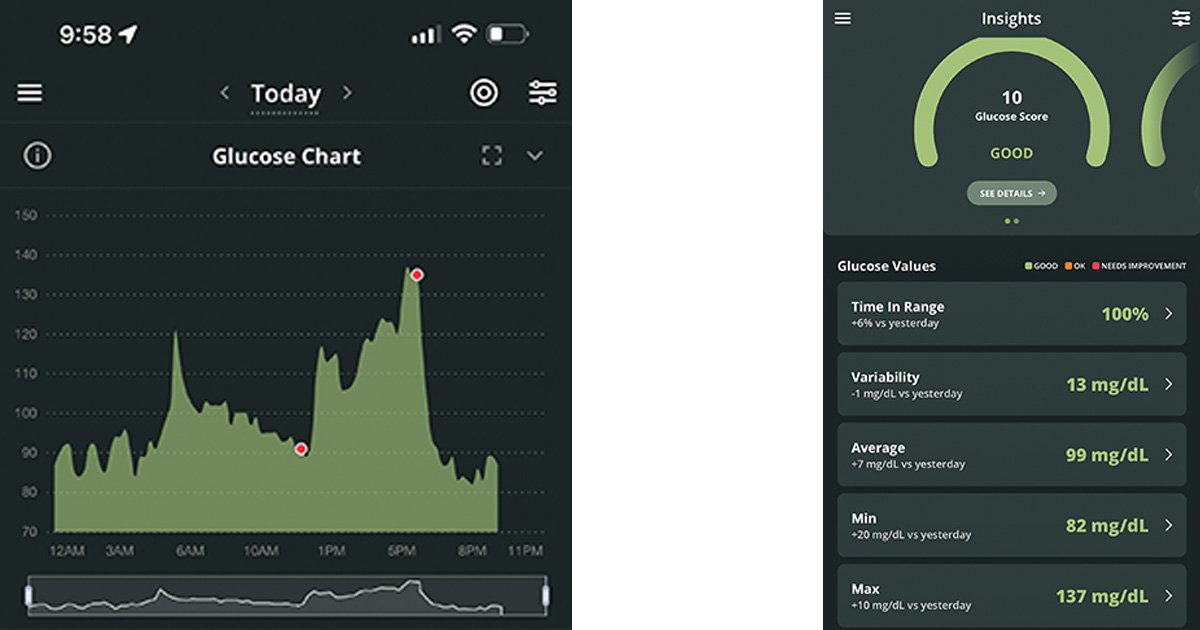
The first big spike is from when I drove to work. So I definitely experienced the dawn phenomenon.
For lunch, went to a Mexican restaurant, no chips, and no tortillas but did have steak fajitas and beans. My glucose levels went up and then peaked on my drive home.
Dinner was a salad and pastrami and my levels immediately went down.
Day 3 of wearing a CGM
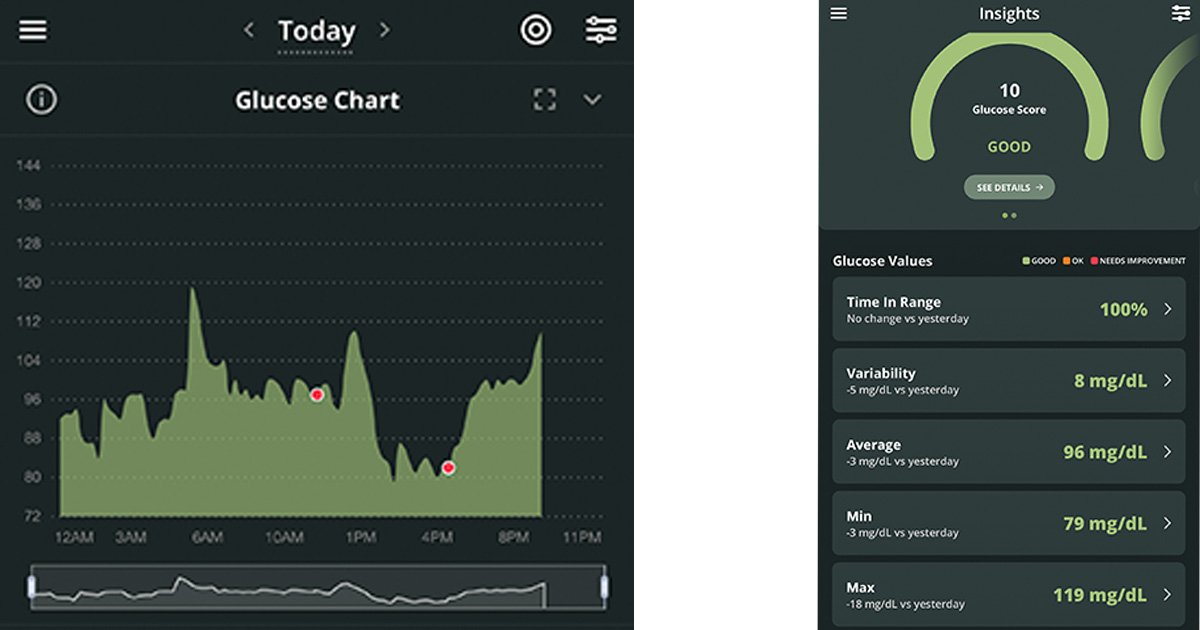
More dawn phenomenon on my way to work.
Lunch was a salad, pork chop with a side of broccoli.
Dinner was a bowl of lentils. Levels slowly went up and did not come back down until after I went to bed.
Day 4 of wearing a CGM

More dawn phenomenon on the way to work (perhaps I need to stop driving to work).
Lunch was a salad, pork chop with a side of broccoli.
Everything looked good until I drove home.
Dinner was Salad and fried chicken (passed on the bread and fries). After dinner, my levels came down.
Day 5 of wearing a CGM

Overall my numbers looked good to me. It was a day off so I did not drive.
Lunch was brisket and Brussel sprouts from a local BBQ place.
Dinner was a salad and grilled salmon.
Day 6 of wearing a CGM
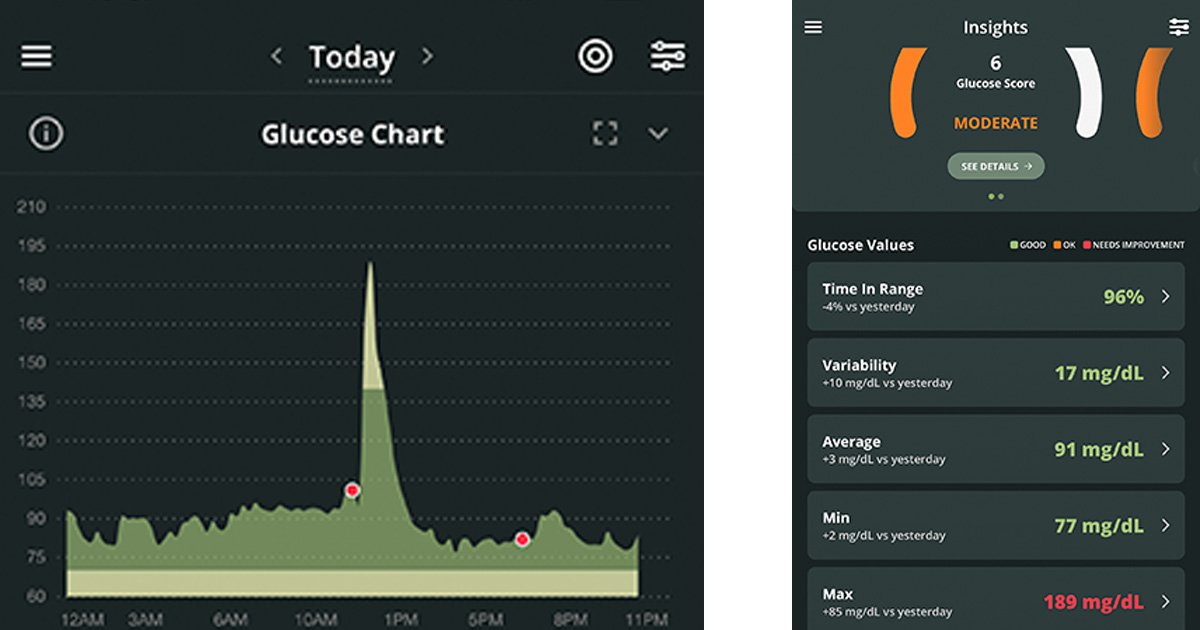
As you can see I had one really big spike in my levels (up to 189). I had a regular Gatorade, not a sugar-free one. So no more sugary drinks for me.
Lunch was grilled chicken, cauliflower, and Gatorade.
Dinner was salad, steak, and broccoli.
Day 7 of wearing a CGM
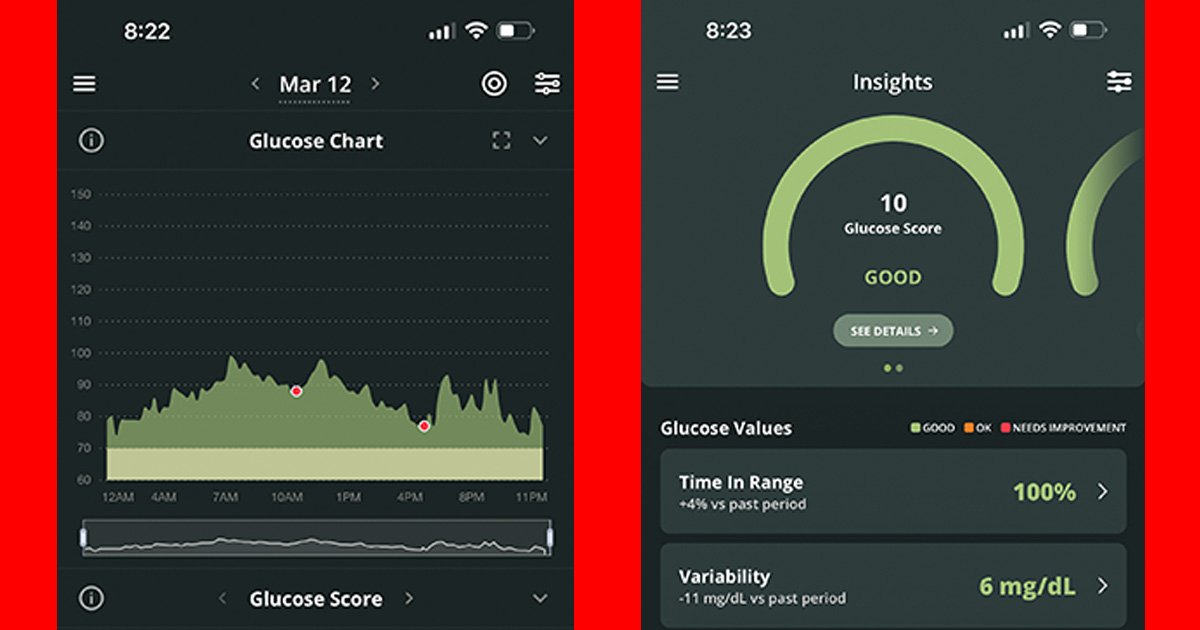
This was a day off for me and the day before we were to fly to Spain for our vacation. So I took it easy around the house.
Lunch was steak and eggs. Dinner was steak, broccoli, and salad. Everything was low carb and experienced no glucose spikes.
Day 8 of wearing a CGM
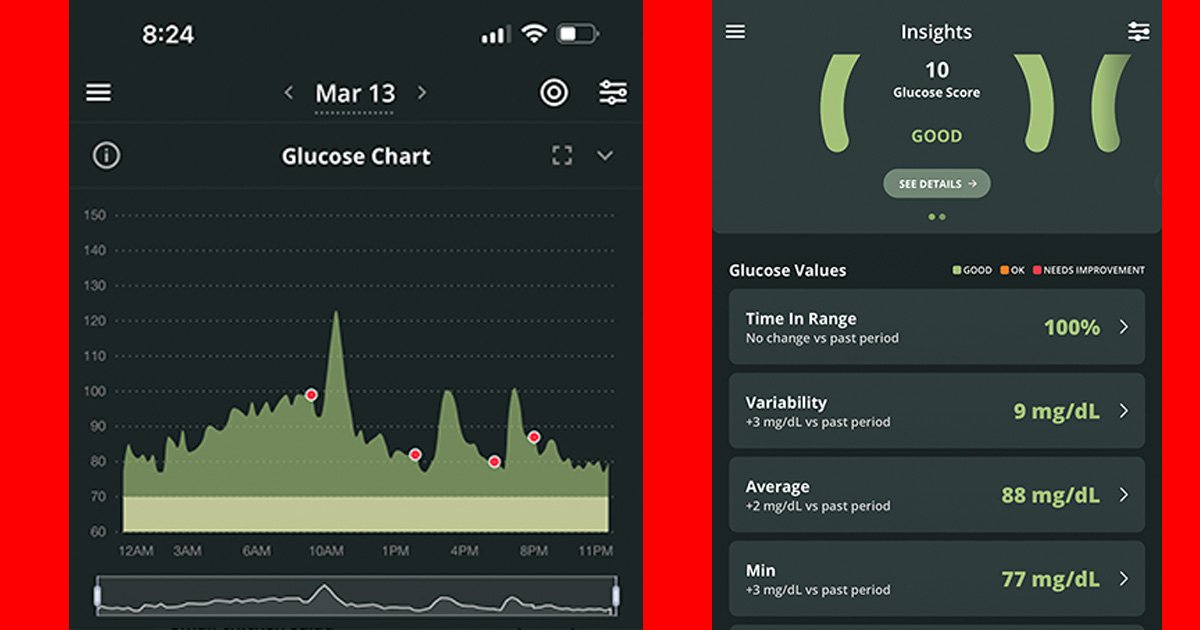
So a very hectic day I fasted until we were in the Atlanta airport. The best choice that I could find was Chinese takeout. Instead of noodles or rice, I went with steamed veggies. But it looks like the sauce had a lot of sugar so my glucose spiked up over 120. Then we fly to JFK.
This is when we started having fun. Our flight to Madrid keep getting pushed back So I started snacking. At just past, midnight Delta canceled our flight. So we went to the hotel to wait for our flight the next evening.
Can you wear a CGM thru airport security?
I wore my CGM thru security first thru a regular X-ray and then thru a Backscatter X-ray (the one where you hold your hands up). If you are asked about it tell them that it is a prescribed medical device.
Day 9 of wearing a CGM

For lunch, we went to a Korean restaurant. I had soft tofu soup (no rice) and some of veggie side dishes. I did pass on the one with sweet potato. For dinner we went to a Columbian restaurant, I basically had steak and veggies.
Day 10 of wearing a CGM
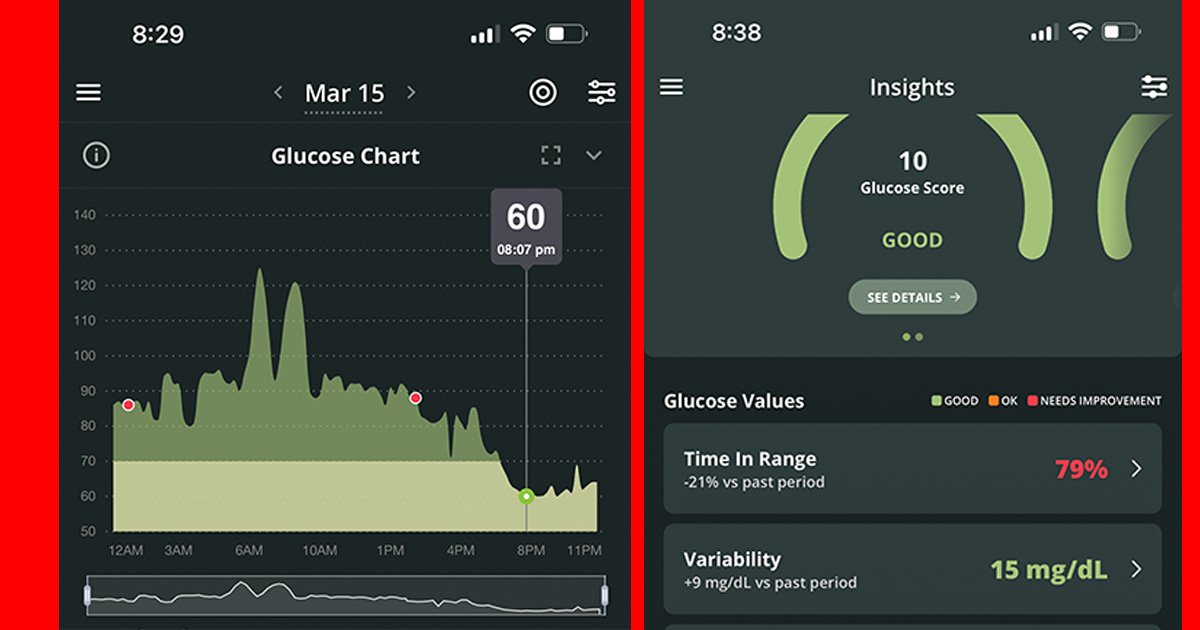
On the flight to Paris (yes rerouted now we had an extra stop), had a light dinner then went to sleep. Everything is looking good.
The two big spikes are from running around the airport in Paris and stress from being on standby for a flight to Madrid.
After we arrived in Madrid (without our bags) had a light dinner and two glasses of wine at the hotel. Then overnight my levels dropped pretty low. Some people in the Facebook group have reported if you sleep on the sensor you can get low readings.
Day 11 of wearing a CGM

You may notice that the times look off. They have recalculated to the time zone that I am currently in.
Had a light breakfast at the airport hotel. Then we changed hotels to one in downtown Madrid. After arriving at the hotel I had two beers while waiting for our room to be ready. That caused a big spike.
After dealing with airlines and trying to get our bags, we did get one. For dinner, I had a fried chicken sandwich that caused another spike. So beer is bad, and breaded and fried food in bread is also bad. Shocking I know.
Day 12 of wearing a CGM

Then we took a train to Valencia. Fasting while traveling does help to simplify things.
For lunch, I had lamb chops and a beer. Yes, beer is still bad.
Dinner was Tapas (lower carb options) and wine. Everything looked good but shortly after going to bed, the sensor lost some data.
Day 13 of wearing a CGM
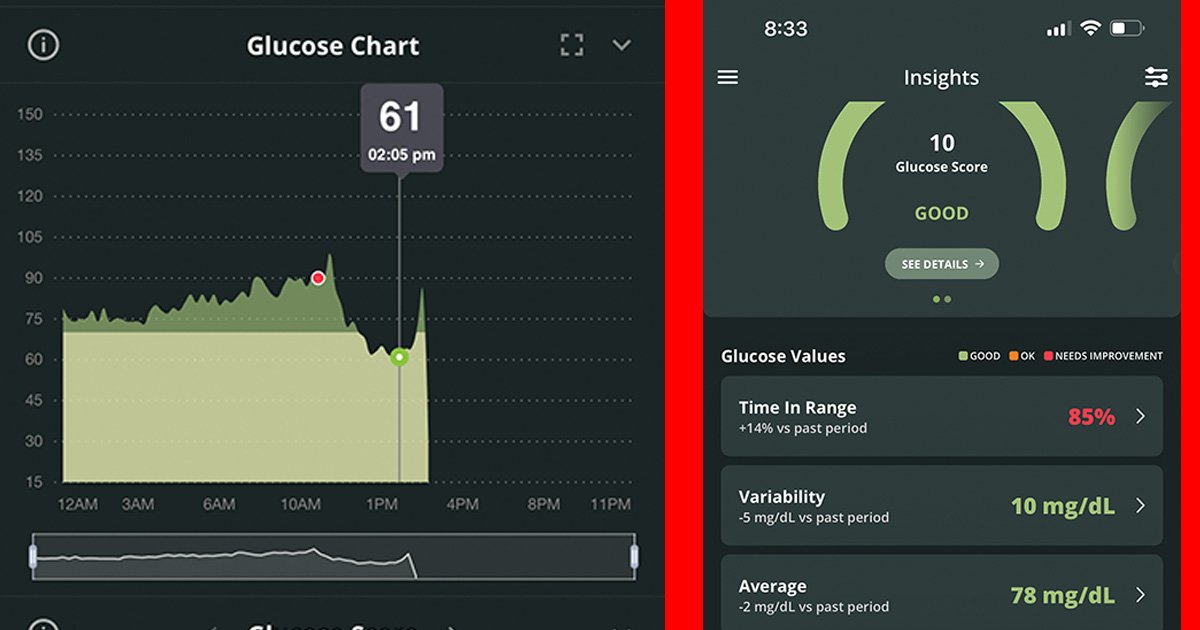
Lunch was Tapas (low-carb options) and wine. Everything was looking good until the sensor stopped collecting data.
I learned a lot wearing a CGM for two weeks and hopefully, this real-world information can help you.
Remember Nutrisense has a $25 off Promo code for you. Use Code JAMES25 at checkout.

